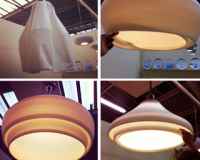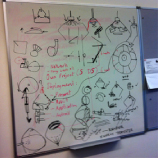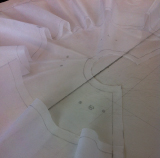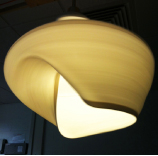Posted on Thu 26 May 2016
Patrick Laing's Research Report
Please begin with who you are and a short description of what you do.I’m a designer with broad spectrum of three-dimensional work, chiefly I'm interested in the play of materials, which goes someway to explain the broad variety of my work. Which stretches from jewellery through…

Posted by
Project

Craft + Technology Residencies: The Flying Skirt Light Shade
At first the light shade hangs in a limp felt form, until is switched on, then it begins to rotate and the skirt opens out, silently spinning like a dancer’s.Please begin with who you are and a short description of what you do.
I’m a designer with broad spectrum of three-dimensional work, chiefly I'm interested in the play of materials, which goes someway to explain the broad variety of my work. Which stretches from jewellery through home ware, furniture and lighting to industrial product, store and exhibition design.
How did you hear about the scheme and what motivated you to apply?
I learnt of the scheme through an email directly from the Crafts Council. I was motivated to apply because of the opportunity to learn new skills and in turn realise ideas that prior to my application appeared so simple but I had often found were complicated to achieve.
What were you expecting? Did the programme live up to your expectations?
The programme was fantastic and I must express my sincere gratitude to all of those involved in creating and sustaining this wonderful opportunity that I have benefited from so greatly.
In my application I had proposed the prototype development of what is now the analogue version of the networked Flying Skirt light shade. My approach was to provide the programme with what I could deduce were the correct materials in order encourage the conversation that i-DAT/Dr. Simon Lock and I needed. This was perhaps provoked by Simons jovial declaration on my first full day that “i-DAT don’t really do hardware”, while I subsequently learnt that this is far from true, it was a very useful prompt that I needed for this very physical object. It did take some time to hunt these substances and parts down but it had to be done to establish a closer bridge between us and it proved to be time well spent. The more I found, the more our conversation was able to develop and the greater our understanding became of what each was able to offer.
The project:
Describe the prototype / concepts that you explored / produced / developed during the residency?
The prototype networked version of The Flying Skirt is a light shade that begins to rotate as the light is flicked on where upon it opens out just like dancers skirt. The skirts form can then be manipulated just like a clay pot on a wheel but in the networked version this deformation can be done remotely. Its possible to sculpt the form just by an individual’s walk and its flux in form can be enjoyed arguable more so than the analogue version because deformations can be appreciated at distance in the instance they happen.

Prototypes began with experiments in scale using existing materials from the analogue version, I had discussed the item with i-DAT staff, MA and PhD students and through introductions by Mike Phillips I met and conversed with engineering lecturers/technicians, 3D and stitch workshop staff. This was followed by rationalising options (see image below) with Simon and then an incremental series of tests with a variety of sourced materials.
By tests and reasoning and much time hunting on the web and phone I found and appropriate material, then it became it about deducing the correct weight via further tests. In order to carry out these studies full size skirts would have to be made, which at the start soaked up much time only to discover in seconds whether the material was appropriate.
Further refinements were needed to discover the means of coercing the material, small fans were suggested by the engineers and certainly it appeared at one point that I was obsessed by the devices however I was acting upon vice from the engineering department. Alternatives were not viable and after a little difficulty the correct combination was found that is both as slight and quite as possible but before we arrived there some playful arrangement of motors and armatures were conceived of.


Finally when the optimum combination was discovered that could create all the forms of the analogue version and gladly new forms too in an elegant and quiet manner Simon and I could then actively seek to engage the data that would convulse the skirt. Its worth noting that this point was only 7 days before the end of residency show, such is the very individual nature of this piece that it absorbed a lot of time to problem solve.
Please describe your experience of bringing together craft and technology and from a makers’ perspective, the process of working with a creative technologist.
What was particularly useful was the opportunity to recognise the border regions of my combined skill sets. This was humbling and healthy as it provided a unique opportunity to reflect on varied abilities while in a creative environment, this alone was a particularly positive experience.
Working with a technologist was in short great fun, I adored being able to ask the kind of questions I have wanted to for so long and enjoyed further the advantage due to the good nature of all i-DAT members thee opportunity to of ask naïve, even silly questions. In the past and certainly on the residency I found that these base questions often provoked bright, sensible intelligent discussion of new things. Metaphor became a key means of bridging understanding between Simon and I in the early days of the residency, with a head up a skirt most of the day in reflection this was hardly surprising but a very useful trick and good for much a positive humour when options appeared limited.
Do you think exploration of the Internet of Things was valuable for you and the technologists you worked with? Why?
Exploring the growing culture of the Internet of Things was of tremendous value to me, simply I feel I have far greater avenues for potential exploration than I did at the start of the year. I believe confidently that Simon and i-DAT found the time valuable, I’m aware that Simon declared that the item “was alive” and he wishes for us to continue developing the item together beyond the residency, something I'm particularly excited about.
Did your ideas change over the course of the residency, how? If yes, what were the inspirations / catalysts that changed your direction / altered your perspectives?
I’m delighted to say that I achieved my aims for the residency, the goal was to use the time to develop a prototype I can finesse in the intervening months and debut at the London Design Festival in September. This goal was realistic but did require long hours to achieve, time I was only more than happy to put in given the terrific opportunity and warm support in Plymouth.
The type of actual item that I wanted to produce wasn’t clear at the outset, I had illustrated options at the interview and rationalised that the experience with i-DAT would reason the best way forward, in hindsight this was a wise approach to take.
Working practices:
How helpful was it to be part of the Pervasive Media Studio / i-DAT / Autonomatic community?
Being part of i-DAT and the wider Pervasive Media Studio / Autonomatic community was fantastically useful, I was always aware that I could make calls for assistance and advice. However it would only be right due to the very particular nature of this project to highlight that it was Simons input that was crucial. His generosity and wit allowed this project to happen, I'm glad to have met him and am only looking forward to working with him more.
Can you give an example to describe or pinpoint how your thinking or way of working has developed as a result of your collaboration with technologists?
Data, much of i-DAT conversation (I shared a work area with BA students) discusses where data is taken from, how it’s toyed with and where it’s sent. This innocent realisation alone was significant and I benefited enormously from further conversations with Simon but also indirectly by listening to students tutorials while I worked. Their own creative issues with staff (often Simon) and how they navigated them begun to influence me, which greatly assisted the project as a whole.
What difference or impact has taking part in the residency made to your practise? Is R&D something that you will incorporate into standard working practices in future?
I will be actively seeking to work with technologist in the future and more so it’s the rational of placing persons together of similar mindsets but different practises that I will also seek. This approach has been enlightening.
How useful did you find documenting your project online through journal entries?
Documenting my progress with the online journal was certainly healthy for the purposes of reflection and attempting to develop a marketing language of my own. I realise now that I was perhaps a little precious in doing that and more posts would have been useful. My reasoning was that I only wanted to upload positive, pertinent newsworthy content and not highlight negative progress or a perceived lack of it.
How useful was the support from the organisations involved in the project - Watershed/Pervasive Media Studio, i-DAT, Autonomatic/AiR and the Crafts Council? Is there anything we could have done better?
The support from all of the bodies connected with the residency was humbling, I relished it. All bodies were open, positive and supportive.
There were a few ID card issues at the University of Plymouth, which did lose me/us some crucial time over such a short residency, this was due to the necessary nature of my designation as an associate. Many associates never visit the University and few would use the variety of facilities I explored. I know that this is happily no longer an issue because of the cracks I exposed in the system which even i-DAT couldn’t haven be aware of in advance.
i-DAT is a terrific department, being that the teaching rooms and MA/PhD students/staff are in different buildings I was initially confused as to who was who. This was as actually quite useful though as I made connections with another department housed in the same space.
I would have enjoyed the experience of presenting my project to the Ba students. The naive questions I mention earlier that were so advantages for me to ask of Simon could well have been useful for them to ask of me and I could have benefited from them in return.
The residency was short and to be taken advantage of did require more attention than was suggested, this said I cant see how anyone given the opportunity would not want to offer it their full attention. To do this certainly required living in Plymouth full time, the cost of travel between Plymouth and London would have been prohibitive. While in Plymouth I was able to balance my other work commitments but there were certain things I choose to put off until I retuned to London. Back in the capital, how much I had put off has affected the prompt return of this report.
The three meet ups in the respective locations were terrific, what with the need to introduce project fresh to new people. This in itself was useful but did often take away from the set theme, a clear sectioning of these different needs could be useful for the future.
Two of the three residency’s were run at academic institutions and the residency show concluded one week after the Easter break commenced, unfortunately this meant that the workshops were closed and when most needed. Planning is vital but sometimes things do break and just being able to weld a new part can be crucial, being alert to the academic timetable will be important in the future.
Will the residency have continued value for you (what/how)?
I’m delighted to say that I have successfully applied for Creative Entrepreneur in Residence Award that will greatly assist the development of The Flying Skirt for debut at the London Design Festival. It has already witnessed early interest and press, please see the following link:
http://www.tentlondon.co.uk/news/flying-skirt#watershedfilm
As I have mentioned previously Simon Lock is keen to continue the work the residency begun, I’m very excited by this and look forward to installing the first purchased networked Flying Skirt with him. Daring to think beyond this there are questions of how large this item could become and what would happen to a group of skirts labouring on the ceiling and feeding off each other?
How do you think the scheme should be developed in the future? Should we run it again?
Please run the scheme again, possible it should be a little longer, a fortnight alone may be enough. Applicants should be aware that to fully take advantage of such a generous offer it will require moving to the technologist base full time.
Did you formulate any collaborations (additional to what you already had on beginning) or find any additional opportunities as a result of this residency?
I remain in touch with many people at i-DAT and there is wonderfully the outside possibility of an app being developed as a result of a traffic game I devised have been playing alone for years in London. The grain of the discussion for the game, came from a late night weekend session where I was working separately to an i-DAT MA student and a recent BA graduate and our conversation on traffic data. As I mention above what is your data source, how can it be played with and where can that new data then be sent. It wasn’t until I begun this residency that I realised I had been in effect playing an app for years.
Further to this I received a contact from a technologist in the last week that had seen the residency film of the device and is keen to employ/work with a material designer on a project of her own creation. I have no idea where this might lead but that a call such as this has come through vindicates the residency in itself.
